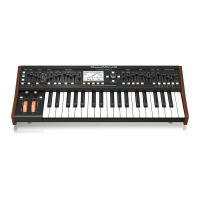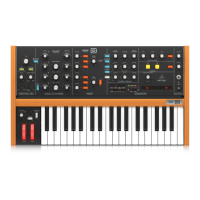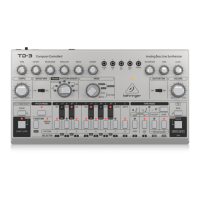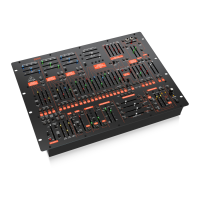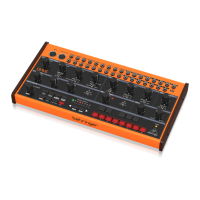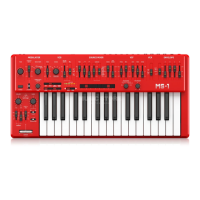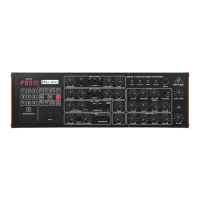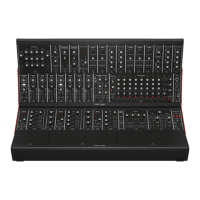5 DeepMind 12 User Manual
1. Introduction
The DeepMind 12 is a True Analog 12-Voice Polyphonic Synthesizer with 4 FX
Engines, 2 OSCs and LFOs per Voice, 3 ADSR Generators, 8-Channel Modulation
Matrix, 32-Step Sequencer, Tablet Remote Control and Built-In Wi-Fi.
The DeepMind 12 was created to serve the creative needs of players, performers,
artists, sound designers, engineers and producers.
The DeepMind 12 oers all the features of a traditional analog polyphonic
synthesizer, and adds incredible new features to enhance and expand the
creative possibilities.
This manual rst describes the terminology used, so that you
understand the unit and its functions. Please read the manual carefully
and keep it for future reference.
1.1 Before you get started
1.1.1 Shipment
The DeepMind 12 was carefully packed in the factory to guarantee safe transport.
Nevertheless, we recommend that you carefully examine the packaging and
its contents for any signs of physical damage, which may have occurred during
transit.
If the unit is damaged, please do NOT return it to us, but notify
your dealer and the shipping company im mediately, otherwise
claims for damage or replacement may not be granted.
1.1.2 Initial operation
Be sure that there is enough space around the unit for cooling purposes and, to
avoid over-heating, please do not place the DeepMind 12 on high-temperature
devices such as radiators or power amps.
WARNING: Blown fuses must only be replaced by fuses of the
same type and rating.
The console is connected to the mains via the supplied cable. It meets the
required safety standards.
WARNING: Please make sure that all units have a proper ground
connection. Foryour own safety, never remove or disable the
ground conductor from the unit or the AC power cord.
1.2 The product manual
The product manual is designed to give you both an overview of the DeepMind 12
analog polyphonic synthesizer, as well as detailed information on each of the
controls and parameters. You will nd an overview of the physical control
elements in the next chapter.
1.3 Preparation
CAUTION: Remember to turn your monitors / loudspeakers on
last when powering up your system, and turn your monitors /
loudspeakers o rst when powering down your system.
2. Features
2.1 Voices
• Twelve independent Voices.
• Two discrete OSCs per voice.
• OSC 1 : Simultaneous Sawtooth and Pulse / Square function.
• OSC 2 : Square with Tone Mod wave shape function.
• Variable Pulse width (OSC1) Tone Mod (OSC2) manual and variable
modulation depth for each OSC.
• Hard sync option: oscillator 2 either syncs to oscillator 1 or can free run.
• Variable Pitch oset for OSC2 (± 1 octave) for harmonic richness.
• Three octave ranges per OSC, 16', 8', 4'.
• OSC drift amount for controllable tuning instability.
• Unison modes (1,2,3,4,6,12 voice) with detune for huge sounds.
• Variable Oscillator 2 level.
2.2 Filters
• 2/4 pole resonant Midas Low-Pass Filter.
• Continuous High-Pass Filter frequency.
• LP Filter can be driven into self-oscillation.
• Switchable Bi-polar lter envelope depth.
• Variable Keyboard / Frequency tracking.
• Switchable +12 db Bass Boost for massive low end.
2.3 Envelopes
• Dedicated VCA, VCF and auxiliary (MOD) envelope Four-stage (ADSR)
envelope generator with continuously variable curves for unique exibility.
• Trigger modes (Key, Loop, Control Sequencer, LFO1, LFO2).
2.4 LFO
• Two LFOs per voice.
• Variable slew rate.
• Mono / Poly / Spread modes for linking and unlinking LFO phase across
voices.
• High maximum LFO rate for cross mod type eects.
• Sine, Triangle, Square, Ramp Up, Ramp Down, Sample and Hold,
Sample and Glide.
• Key Sync on/o.
• Clock sync (internal or external MIDI clock).
• Delay and Fade in Per LFO.
• High maximum LFO rate which can track note number via mod matrix for
cross mod type eects.
2.5 VCA
• Stereo VCA per voice with overall pan spread control and individual voice
pan modulation.
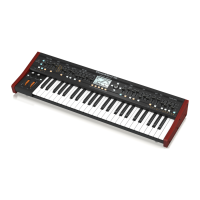
